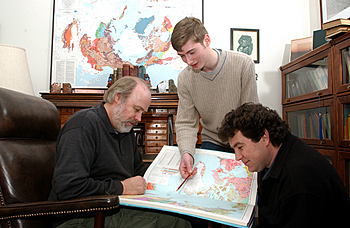
Streletskiy, a native of Russia who holds bachelor's and master's degrees in geography from Moscow State University, has extensive experience in the Arctic, having worked in Alaska, Novaya Zemlya, Svalbard and several parts of Siberia. He first came to UD under a Russian Federation Presidential Scholarship in 2004. After returning to Russia to finish his master's degree, Streletskiy began doctoral studies at UD in fall 2005.
His dissertation work, co-supervised by UD geographers Nikolay I. Shiklomanov and Frederick E. Nelson, is a statistical examination of the spatial and temporal variability of soil thaw at the more than 150 permafrost observatories in the Circumpolar Active Layer Monitoring (CALM) network. The CALM program is supported by the National Science Foundation's Office of Polar Programs through a five-year, $1.2 million grant to Nelson and Shiklomanov, and is administered through the UD Department of Geography.
Streletskiy's presentation, entitled “Frost Heave and Thaw Settlement in Permafrost Environments: Applications of Differential Global Positioning Systems Technology,” described the use of high-resolution Global Positioning Systems (GPS) to gain insight into vertical movements of the ground surface in tundra environments of northern Alaska. In recent years it has become common knowledge that permafrost is warming throughout the Arctic.
The thickness of the annually thawed layer above permafrost known as the “active layer,” however, has not been increasing in northern Alaska over the past 15 years, in contrast to the situation in many other parts of the Arctic. The Alaskan active-layer anomaly was noted prominently in the United Nations' recent Intergovernmental Panel on Climate Change Fourth Assessment Report.
To gain insight into this apparent discrepancy, the UD Permafrost Group (UDPG) has been using differential GPS to monitor surface elevation in the Brooks Range Foothills and the Arctic coastal plain since 2000. Data from biannual GPS surveys, used in conjunction with air and soil temperature data, indicate that an ice-rich layer at the top of the permafrost has been degrading over the period of observation. The loss of volume that accompanies melting of the ground ice has resulted in “thaw consolidation” and subtle subsidence of the ground surface, but without apparent increase in active-layer thickness.
Streletskiy's presentation demonstrated that the ice-rich upper permafrost of northern Alaska is indeed degrading, and indicates a need for adjustments to be made in permafrost monitoring programs. With colleagues Galina Mazhitova of the Russian Academy of Sciences and former UD grad student Jon Little, UDPG is preparing a version of the study for publication in a high-visibility journal.
The Association of American Geographers is a 10,000-member organization focused on geographic theory, methods and education. The organization was founded in 1904 by Harvard University geographer William Morris Davis. Ralph Stockman Tarr, a doctoral student of Davis, was professor of physical geography at Cornell University and worked extensively in Alaska. The award named in his honor is given annually and includes a plaque and a cash stipend.
Article by Neil Thomas
Photo by Kathy Atkinson


